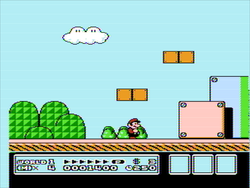Nintendo Entertainment System emulators
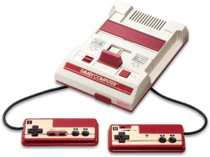
| |
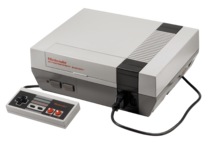
| |
| The Family Computer (above) and Nintendo Entertainment System (below). | |
| Developer | Nintendo |
|---|---|
| Type | Home video game console |
| Generation | Third generation |
| Release date | 1983 (Famicom) 1985 (NES) |
| Discontinued | 1995 (NES) 2003 (Famicom) |
| Predecessor | Color TV-Game |
| Successor | Super Family Computer / Super Nintendo Entertainment System |
| Emulated | ✓ |
The Nintendo Entertainment System (NES) is an 8-bit, third-generation console originally released as the Family Computer or Famicom, in Japan, on July 15, 1983. The Famicom retailed for ¥14800. The console would be redesigned as the NES and released on October 18, 1985 in North America. The NES retailed for $179.99. It had a Ricoh 2A03 CPU at 1.79 MHz with 2 KBs of RAM.
The earliest games released on the Famicom suffered from significant hardware constraints due to the way the Famicom was designed: limited memory addressing (which meant games had a small maximum ROM size), how the graphics were loaded onscreen, just the native sound processing was available, no saving... To solve this problem, Nintendo came up with two solutions:
- The Family Computer Disk System (FDS). A Japan-only add-on that played games from a semi-custom variant of Mitsumi's Quick Disk format. It offered slightly higher data storage and slightly enhanced sound processing. It also had a microphone never found anywhere else. There were plans to release it in the US; however, since the NES had its launch delayed to late 1985, and the mapper solution obsoleted it, the add-on was never exported, and some of its exclusives were ported as regular cartridge releases.
- Memory Management Controllers (MMC), also known colloquially as mappers. They solved every aforementioned problem with bank switching for much more data, onboard FM audio chips, and much more. Most games released after 1986 that really pushed the system to its limits used mappers. A similar solution was used for the Game Boy.
Emulation for the Famicom/NES is robust, with many high-quality emulators for various systems and cycle-accurate emulation possible on even moderately powerful devices.
Contents
Emulators[edit]
Like for Game Boy/Color, tons of NES emulators exist. For a list of open-source projects, see this GitHub query.
| Name | Platform(s) | Latest version | Hardware Variants |
Enhancements | Peripherals | Mappers Support Level |
Accuracy | FLOSS | Active | Recommended |
|---|---|---|---|---|---|---|---|---|---|---|
| PC / x86 | ||||||||||
| Mesen | Dev builds libretro core 2023-09-11 (Mesen X) 0.9.9 (Mesen 1) |
~ | ✓ | ✓ | Unlicensed | Cycle | ✓ | ✓ | ✓ | |
| puNES | WIP builds 0.111 |
~ | ✓ | ✓ | Unlicensed | Cycle | ✓ | ✓ | ✓ | |
| Nestopia UE | libretro core 1.52.1 Nestopia JG git |
~ | ~ | ✓ | Unlicensed | Cycle | ✓ | ✓ | ✓ | |
| FCEUX | 2.6.6 libretro (FCEUmm) |
~ | ~ | ✓ | Unlicensed | High | ✓ | ✓ | ✓ | |
| ares | git Artifacts v137 |
~ | ✗ | ~ | ? | High | ✓ | ✓ | ~ | |
| BizHawk | Dev Builds 2.9.1 |
~ | ✗ | ~ | ? | ? | ✓ | ✓ | ~ | |
| Nintendulator/NRS | 2023-12-23 0.985 Beta |
~ | ✗ | ~ | Unlicensed | Cycle | ✓ | ✓ | ~ | |
| 3dSen | 0.9.8 | ✗ | ~ | ✗ | Only for selected titles | Game dependent | ✗ | ✓ | ~ | |
| MAME | git artifacts[N 1] 0.265 libretro core |
✓ | ~ | ~ | Unlicensed | ? | ✓ | ✓ | ✗ | |
| QuickNES | libretro core 0.7.0b1 (legacy) |
~ | ~ | ~ | ? | ? | ✓ | ~[N 2] | ✗ | |
| BeesNES | git | ✗ | ~ | ✗ | ? | Subcycle | ✓ | ✓ | ✗ (WIP) | |
| breakNES | 2.2 | ✗ | ? | ✗ | ? | Gate-level | ✓ | ✓ | ✗ (WIP) | |
| MetalNES | git | ✗ | ✗ | ✗ | ? | Transistor-level | ✓ | ~ | ✗ (WIP) | |
| jgenesis | 0.7.0 | ✓ | ✓ | |||||||
| jgnes | git | Licensed | Cycle-based | ✓ | ✓ | |||||
| ANESE | 0.9.1 | ? | ~* | ~ | ? | ? | ✓ | ~ | ✗ | |
| iNES | 6.1 | ~ | ✗ | ~ | ? | ? | ? | ✓ | ✗ | |
| HDNes | git | ? | ~* | ? | ? | ? | ✓ | ✓ | ✗ | |
| FinalBurn Neo | libretro core WIP builds |
✗ | ✗ | ~ | ? | ? | NC | ✓ | ✗ | |
| higan (火眼) byuu (謬/view) |
v110 | ? | ✗ | ~ | ? | Cycle | ✓ | ✗ | ✗ | |
| VirtuaNES | 0.97 | ? | ? | ? | ? | Low | ✓ | ✗ | ✗ | |
| nemulator | 4.4 | ? | ? | ? | ? | Medium | ✗ | ✗ | ✗ | |
| Nesemu | 0.0.5 | ? | ? | ? | ? | ? | ✓ | ✓ | ✗ | |
| HalfNES | 062 | ? | ? | ? | ? | ? | ✓ | ✗ | ✗ | |
| Jnes | 1.2.1 | ? | ? | ? | ? | ? | ✗ | ✗ | ✗ | |
| NESticle | x.xx (DOS) 0.42 (Win9x) |
? | ? | ✗ | ? | Low | ✗ | ✗ | ✗ | |
| RockNES | 5.80 | ? | ? | ? | ? | High | ✗ | ✗ | ✗ | |
| RetroCopy | 0.960 1.00 Beta 5 |
? | ? | ✗ | ✗ | ✗ | ||||
| Mobile / ARM | ||||||||||
| Nestopia_libretro | libretro core | ~ | ~ | ~ | Unlicensed | Cycle | ✓ | ✓ | ✓ | |
| FCEUmm_libretro | libretro core | ~ | ~ | ~ | Unlicensed | High | ✓ | ✓ | ✓ | |
| NES.emu | 1.5.77git (Android) 1.5.46.02 (Pyra) |
? | ? | ? | Unlicensed | ? | ✓ (Android only) |
✓ | ✓ | |
| FreeiNES | 6.1.4 (Android) 3.6.5 (Maemo) 3.6 (Symbian) |
? | ~* | ? | ? | ? | ✗ | ✓ | ~ | |
| VGBANext | 6.6.6 | ? | ? | ? | ? | ? | ✗ | ✓ | ~ | |
| GPFCE | 0.81.0.r2 (Pandora) 0.4 r313 (GP2X) 0.4+ (Wiz) |
? | ? | ? | ? | ? | ✗ | ✗ | ~ | |
| vNES | 1.7 (S60v3)git 1.2alt |
? | ? | ? | ? | ? | ✓ | ✗ | ~ | |
| Nostalgia.NES | 2.0.9 | ? | ? | ? | ? | ? | ✗ | ✗ | ~ | |
| John NESS | 1.09 | ? | ? | ? | ? | ? | ✗ | ✓ | ✗ | |
| Jnes | 1.2.6.26 | ? | ? | ? | ? | ? | ✗ | ~ | ✗ | |
| nesemu | 0.2.3 Beta Preview (Pandora)V1 (Wiz) 0.2 (Dingoo) |
? | ? | ? | ? | ? | ✓ | ✗ | ✗ | |
| Nestopia | V2 | ? | ? | ? | ? | Cycle | ✗ | ✗ | ✗ | |
| Nesemu | git | ? | ? | ? | ? | ? | ✓ | ✓ | ✗ | |
| Pocket Nester+ | 0.9 | ? | ? | ? | ? | ? | ✗ | ✗ | ✗ | |
| nintaco | 2020-05-01 | ~ | ✗ | ? | Unlicensed | Cycle | ✓ | ✗ | ✗ | |
| 8-Bit Wonders | 0.8 (F-Droid) 0.8 (Play) 0.8 (Amazon) git |
? | ? | ? | ? | ? | ✓ | ✓ | roadmap | |
| Consoles | ||||||||||
| Nestopia | libretro core | ~ | ~ | ~ | Unlicensed | Cycle | ✓ | ✓ | ✓ | |
| QuickNES | libretro core | ~ | ~ | ~ | ? | ? | ✗ | ~[N 2] | ✓ | |
| FCEUmm | libretro core | ~ | ~ | ~ | Unlicensed | High | ✓ | ✓ | ✓ | |
| FCE Ultra GX | 3.5.3 | ? | ? | ~ | Unlicensed | High | ✓ | ✓ | ✓ | |
| pNES | git | ? | ? | ~ | ? | ? | ✓ | ✓ | ~ | |
| FCEUltra for PS2 | 0.9.3 0.90i Mod |
? | ? | ? | ? | High | ✗ | ~ | ~ | |
| Neon64 | git | ? | ? | ? | ? | ? | ✓ | ✓ | ~ | |
| nesDS | 1.3a | ? | ? | ? | ? | ? | ✗ | ~ | ~ | |
| PocketNES | 7-1-2013 | ? | ? | ? | ? | ? | ✗ | ✗ | ~ | |
| Nintendo Switch Online (L-CLASSICS) | 2.3.0 | ? | ~ | ? | ? | ? | ✗ | ✓ | ~ | |
| Virtual Console | N/A | ? | ? | ? | Official | ? | ✗ | ✗ | ~ | |
| NES Remix (Heritage) |
HeriC | ✗ | ✗ | ? | ? | ? | ✗ | ✗ | ~ | |
| VirtuaNES for 3DS | git | ? | ? | ? | ? | Low | ✓ | ✗ | ✓ | |
| NESBox | v4 | ? | ? | ? | ? | ? | ✗ | ✓ | ✗ | |
| Mega Everdrive Pro | N/A | ? | ? | ? | ? | ? | ✗ | ✓ | ~ | |
| NesterJ[N 3] | 1.13 beta 2 AoEX |
? | ? | ? | ? | ? | ✓ | ✗ | ✗ | |
| imbNES | 1.3.2 | ? | ? | ? | ? | ? | ✓ | ✗ | ✗ | |
| Project Nested | git | ? | ? | ? | ? | ? | ✓ | ✗ | ✗ | |
| NeMul | 1.0 | ? | ? | ? | ? | ? | ✗ | ✗ | ✗ | |
| Calculator | ||||||||||
| numworks-nofrendo | git | ? | ? | ? | ? | ? | ✓ | ✓ | ✗ | |
| NESpire | 0.30 git (tangrs-mod) |
? | ✗ | ? | ? | ? | ✓ | ✗ | ~ | |
| NESizm | 1.00 | ? | ✗ | ? | ? | ? | ✓ | ? | ~ | |
- ↑ CI-Windows CI-Linux CI-Macos
- ↑ 2.0 2.1 Libretro core is still active.
- ↑ AoEX is based on NesterJ 1.12 Plus 0.61 RM, which includes features like rewind, cheat code support, rotated/mirrored screen, sepia palette, support for rare mappers (the pirate bootleg FF7 works on it), etc. Its compatibility is inferior to 1.13 beta 2.
Comparisons[edit]
- Mesen is a cycle-accurate NES emulator. Also, it is very user-friendly and supports lots of enhancements, peripherals, variants and mappers that other emulators are missing. It also supports goodmerged. Latest versions require .NET 6. This is the most compatible NES emulator of the cycle-accurate variety.
- puNES is another cycle-accurate NES/FDS emulator. It is deemed as the second most compatible NES emulator of the cycle-accurate variety.
- Nestopia also is a cycle-accurate NES/FDS emulator. Nestopia has issues with The Young Indiana Jones Chronicles and doesn't display the status bar in Mickey's Safari in Letterland correctly (among other problems). Nestopia Undead Edition is a fork of Nestopia meant to keep it alive and fix the aforementioned bugs. This version is generally recommended over vanilla. Even the libretro core for Nestopia is the Undead Edition.
- Nintendulator also is a cycle-accurate NES/FDS emulator. NintendulatorNRS is a fork of Nintendulator that supports the Famicom Disk System, rare mappers, VRT chipsets, and many unlicensed and bootleg carts and systems.
- FCEUX is a highly-accurate NES/FDS emulator and it supports lots of unlicensed mappers, on top of this it's a recommended emulator on TAS Videos. The New PPU implementation is more accurate than the Old PPU implementation. The emulator is very useful; thanks to its robust Lua scripting and incorporating FCEUmm into its feature set.
- BeesNES is aiming for subcycle accuracy. Currently it is a work-in-progress, but it is already including enhancements like; NTSC-CRT, debugger, disassembler, assembler and various TAS features.
- breakNES is aiming for gate-level accuracy. Currently it is a work-in-progress and requires .NET 6.
- MetalNES is aiming for transistor-level accuracy, however it is a currently work-in-progress.
- For official emulation, there is Nintendo's own Virtual Console or Nintendo Switch Online. The Wii has a significantly larger library of NES games to choose from than the 3DS or Wii U, especially from third-party publishers.
There are many other NES emulators not listed here, as the NES has more emulators than any other system (new ones are started all the time). Only those that are well-known or stand out in some ways are covered here.
Mappers[edit]
A key difference between many emulators nowadays is how many mappers they support.
- No mapper: Supported on every emulator, even official Nintendo emulators.
- Official mappers (UNROM, AOROM, MMC1-6): Most emulators, as well as Nintendo's Virtual Console (but not their GBA emulators), will cover these.
- Third-party mappers (Various: e.g., Konami's VRC6/VRC7) While officially licensed by Nintendo, they were not allowed outside Japan. As a result, for their Western releases, many games that took advantage of their features (advanced ROM mapping, extra sound channels) were reprogrammed significantly and shipped on the official mappers, often with simplified soundtracks. A lot of fan emulators worth their salt will cover these. With those, you cover the entire officially licensed library.
- Unlicensed mappers: Mostly used by pirate cartridges, often long past the console's official commercial lifespan. Only the most active and recommended emulators will even bother covering them in a whack-a-mole quest for every new one discovered to this very day. If you're not interested in unlicensed Chinese or Russian bootlegs or newer unofficial NES demakes, it isn't a problem.
The NES ROM information isn't sufficient to describe the cartridge and emulate it, so emulators have to include the layout and behavior of these mappers in their code. At the same time, the ROM header tells the emulator which mapper to choose. So unlike with other consoles, no matter how accurate a given NES emulator will get, it will still never be able to run newly discovered ROM dumps from cartridges that used a so-far unknown mapper. Thus, Unlicensed NES support will be inevitably incomplete and a constant work-in-progress, hence claims some emulators are "inaccurate".
Related to this issue: This is why most emulators won't run unheadered NES ROMs. Newer versions of Nestopia can open those, but they're handled in a slightly different way: the information that would have been included in the iNES header is instead provided in emulator configuration files that get summoned as long as the ROM's hash matches exactly the No-Intro dump of that given game (which is inconvenient for ROM hacks).
Enhancements[edit]
| Name | Mesen | FCEUX | puNES | Nestopia UE | ares | QuickNES | MAME | BeesNES | breakNES | MetalNES | Nintendo Switch Online (L-CLASSICS) | |
|---|---|---|---|---|---|---|---|---|---|---|---|---|
| Graphics | Resizable Internal Resolution | For emulation of 2D systems, the resolution can only be upscaled, making the pixels more apparent. | ||||||||||
| Widescreen hack Using wideNES technique (similar to wideGB); it can automatically “map-out” levels and worlds in NES games. |
Exclusive to ANESE emulator at the moment. | |||||||||||
| Sprite Replacement | ✓* | ✗ | ✓ | ✗ | ✗ | ✗ | ✗ | ✗ | ✗ | ✗ | ✗ | |
| Performance | Overclock | ✓* | ✓ | ✓ | ✗ | |||||||
| TAS features | Macros/Scripts/Lua | ✓* | ✓ | ✗ | ✓* | |||||||
| Rewind | ✓* | ✗ | ✓ | ✓ | ✓ | |||||||
| Fast-Forward/Turbo Speed | ✓* | ✓ | ✓ | ✓ | ||||||||
| Savestates | ✓ | ✓ | ✓ | ✓ | ✓ | |||||||
| Movie recording/playback | ✓* | ✓ | ✓ | ✗ | ✗ | ✗ | ||||||
| Post-Processing | Filters | ✓ | ✓ | ✓ | ✓ | ✓ | ✓ | ✓ | ✓ | ? | ? | ✓ |
| AI-powered filter compatible (Freestyle) |
? | ? | ? | ? | ? | ? | ? | ? | ? | ? | ? | |
| Shader Chain | ~[N2 1] | ~[N2 1] | ~[N2 1] | ✗ | ✓ | ~[N2 1] | ||||||
| Inverse tone mapping compatible | ? | ? | ? | ? | ? | ? | ? | ? | ? | ? | ? | |
| Quality of life | Per-Game Profiles | ✓* | ? | ✓ | ? | ? | ? | ? | ? | ? | ? | ? |
| Command Line Options | ✓* | ? | ? | ? | ? | ? | ? | ? | ? | ? | ? | |
| Built-in Cheat Manager | ✓* | ? | ✓ | ? | ✓* | ✓ | ✓ | ? | ? | ? | ? | |
| Built-in Custom resolution/CRTSwitchRes For using this on Windows OS you need CRT Emudriver. Another option is using EDID editor tool such as "Custom Resolution Utility". |
Exclusive to libretro cores and GroovyMAME at the moment. Also there is a project for achieving software emulators like libretro cores and GroovyMAME send the raw RGB data over a network to a core running on MiSTer, it basically turns the MiSTer into a GPU for the emulator allowing for easy setup and use with CRT TVs/Arcade monitors. | |||||||||||
| Streamable compression format | ✓* | ✓ | ✓ | ? | ? | ? | ||||||
| Big Picture Mode | ~[N2 1] | ~[N2 1] | ~[N2 1] | ~[N2 1] | ✗ | ✓ | ✓ | ✓ | ||||
| Controls | Input lag-mitigating technique | ✓* | ✓ | ? | ? | ? | ||||||
| Misc | Netplay | ✓* | ✓ | ✗ | ✓ | ✗ | ✓ | ✗ | ? | ? | ? | ✓ |
| EmuVR support | Exclusive to libretro cores at the moment. | |||||||||||
| RetroAchievements | ~[N2 1] | ~[N2 1] | ✗ | ~[N2 1] | ✗ | ✓ | ✗ | ✗ | ✗ | ✗ | ✗ | |
| Debug features | ✓* | ✓ | ✗ | ? | ? | ✗ | ✓* | ? | ? | ? | ✗ | |
Peripherals[edit]
There were many accessories released for the Famicom and NES but Emulation in General only covers accessories that are truly differentiated data streams from the basic controller. For example, the Power Glove is, in actuality, just a really complicated NES controller designed to convert motion into D-PAD, SELECT, START, A, and B button commands. The same goes for R.O.B. and his Stack-up and Gyromite games because he was really just the second player. Strangely, the Famicom has a lot more peripheral hardware to emulate than the NES.[1][2]
| Picture | Name(s) | Description | Game(s) | Support emulator(s) | Note |
|---|---|---|---|---|---|

|
Zapper | An electronic light gun accessory that allows players to aim at the display and shoot various objects that appear on the screen. | The Adventures of Bayou Billy Barker Bill's Trick Shooting Day Dreamin' Davey Duck Hunt Freedom Force Gotcha! The Sport! Gumshoe The Hunt for Red October Hogan's Alley Laser Invasion The Lone Ranger Mechanized Attack Operation Wolf Shooting Range To the Earth Track & Field II Wild Gunman |
Various | Emulated in the form of a mouse click (PC), tap (for mobile), remote (Wii ports of NES emulators), or faked pointers using a controller. |
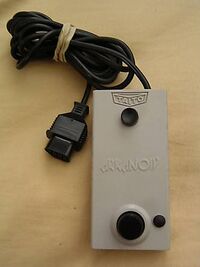
|
Arkanoid/Vaus Controller | A specific game controller with one button to "fire" and a dial to control back-and-forth movement. | Arkanoid Arkanoid: Revenge of Doh Chase H.Q. |
Various | N/A |
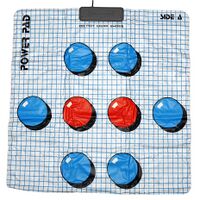 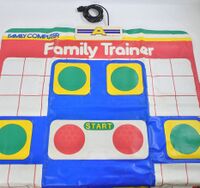 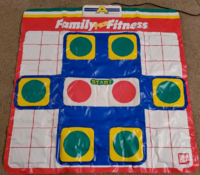 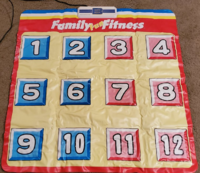
|
Power Pad Family Trainer Family Fun Fitness |
A game controller that allows players to step on a gray floor mat with 12 pressure-sensors embedded between flexible plastic to control gameplay. | Stadium Events Dance Aerobics Athletic World |
FCEUX | N/A |
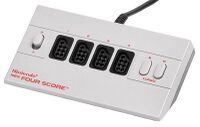 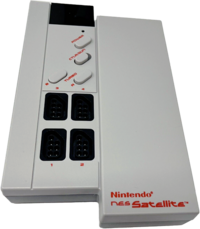
|
NES Four Score NES Satellite 4-Player Adaptor |
A multitap accessory that enables up to 4-player gameplay using infrared wireless communication. | R.C. Pro-Am II Bomberman II[N 1] Gauntlet II Nintendo World Cup A Nightmare on Elm Street |
Various | Emulated by having the option to switch between 2-player and 4-player mode or just enabling/disabling Player 3 and Player 4's controller. |

|
Family Computer Disk System & FDS | See above | Super Mario Bros. 2 Legend of Zelda: The Hyrule Fantasy Zelda II: The Adventure of Link Metroid Light Mythology: Palutena's Mirror Akumajō Dracula Ice Hockey |
Mesen puNES Nestopia UE ares BizHawk Nintendulator NRS FCEumm_libretro FinalBurn_Neo higan MAME iNES Jnes RockNES Others... |
The BIOS file (which can be found here) is required for FDS emulation. Note that there are two versions of the BIOS: one that comes with FDS and another that comes with Sharp's Twin Famicom. They function identically despite showing a different intro during the first boot. |
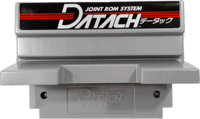
|
DATACH Datach Joint ROM System |
Bandai add-on that lets the Family Computer play a few suitable games. Swiping cards to obtain a character. | Dragon Ball Z: Gekitō Tenkaichi Budōkai Crayon Shin-Chan: Ora to Poi Poi Yu Yu Hakusho: Bakutou Ankoku Bujutsukai Ultraman Club: Supokon Fight! SD Gundam: Gundam Wars Battle Rush: Build Up Robot Tournament J. League Super Top Players |
MAME[N 2] Mesen[N 2] puNES[N 2] FCEUX[N 2] |
N/A |
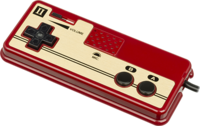
|
Microphone | A Japan-exclusive, built-in feature in the original Player 2 Famicom controller that allows players to use an external sound source (e.g., the player's voice) as input. | Atlantis no Nazo Bakushou!! Jinsei Gekijou Bakushou!! Jinsei Gekijou 2 Doraemon Family BASIC V3 Kaiketsu Yanchamaru Kamen Rider Club: Gekitotsu Shocker Land Light Mythology: Palutena's Mirror Star Luster Star Soldier Super Chinese 2 Takeshi's Challenge The Hyrule Fantasy: Legend of Zelda |
Mesen[N 3] puNES[N 3] VirtuaNES[N 3] Virtual Console[N 4] |
N/A |

|
Family BASIC | A Japan-exclusive peripheral with an enhanced BASIC programming language dialect. It allows users to create programs in the Famicom. It has a specially designed cartridge, keyboard, and Data Recorder. | Family BASIC Family BASIC V3 |
Mesen Nestopia UE FCEUX puNES VirtuaNES |
N/A |
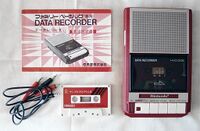
|
Family Computer Data Recorder | A Japan-exclusive compact cassette tape data interface as an addition to the Family BASIC to save data from BASIC programs created by users. The Data Recorder was also used in a select number of games as a method of saving data. | Family BASIC Family BASIC V3 Arkanoid II Castle Excellent Excitebike Lode Runner Mach Rider Nuts & Milk Wrecking Crew |
Mesen Nestopia UE puNES VirtuaNES |
N/A |
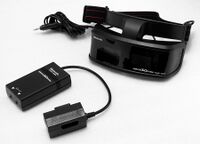
|
Family Computer 3D System | A Japan-exclusive active shutter glasses headset that allowed compatible games to display a stereoscopic image for a 3D experience. | Attack Animal Gakuen Cosmic Epsilon Falsion Famicom Grand Prix II: 3D Hot Rally Fuuun Shourin Ken: Ankoku no Maou Highway Star JJ: Tobidase Daisakusen Part II |
RetroArch Ares? |
GLSL shaders are needed for RetroArch to simulate the 3D experience with a VR headset, 3D TV, 3D projector or Android phone with cardboard. |

|
Miracle Piano Teaching System | An accessory that used an electronic MIDI keyboard as input. | Miracle Piano Teaching System | MAME no$nes Nintaco FCEUX mod MiSTer |
N/A |
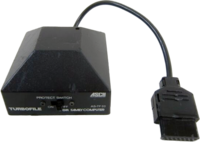 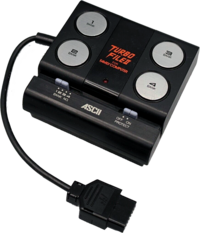
|
ASCII TurboFile ASCII TurboFile II |
A Japan-exclusive external storage device for saving game positions on Famicom. | Wizardry: Proving Grounds of the Mad Overlord Wizardry II: The Knight of Diamonds Downtown Nekketsu Monogatari Haja no Fūin |
VirtuaNES | N/A |
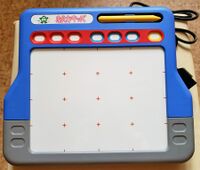
|
Oeka Kids Tablet | A Japan-exclusive drawing tablet for the Famicom Oeka Kids series.[3] | Oeka Kids: Anpanman no Hiragana Daisuki Oeka Kids: Anpanman to Oekaki Shiyou!! |
Mesen Nestopia UE FCEUX puNES VirtuaNES |
N/A |
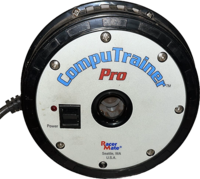
|
RacerMate CompuTrainer Pro | A rare series of peripherals for the game RacerMate Challenge II. It has an interface box, a bike trainer, and a handlebar display.[4] | RacerMate Challenge II | N/A | N/A |
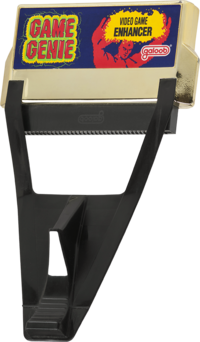
|
Game Genie | A pass-through device that is attached between a cartridge and the console that allows the player to manipulate various aspects of games and access unused assets and functions by temporarily modify game data. | Various | FCEUX[N 5] puNES[N 5] |
Most emulators have a GUI to manage cheats and don't rely on real hardware cheating devices. |
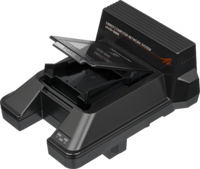
|
Family Computer Network System | A Japan-exclusive network peripheral that allowed users to connect to a Nintendo server that provided extra content such as jokes, news, game tips, weather forecasts, horse betting and downloadable content via dial-up modem. | N/A | N/A | N/A |
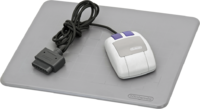
|
SNES Mouse | There have been quite a few NES romhacks coming out that add support for the SNES mouse to NES games. | Maniac Mansion Mouse Hack | Mesen | There is a feature request for adding this to fceumm-libretro. |
Hardware variants[edit]
PlayChoice-10[edit]
MAME is the only emulator that properly emulating the PlayChoice-10 system at the moment, most of the NES emulators only play the PlayChoice-10 games as a normal NES game.
VS. System[edit]
An arcade system based on the NES released for the US. It was released in two different cabinet variations: Vs. UniSystem and Vs. DualSystem. The latter has double chipsets on the PCB and is capable of handling two different programs or simply two separate copies of a single program simultaneously.
Most emulators support games in Vs. UniSystem cabinet by setting up different DIP switches. But only the MAME, Mesen, NintendulatorNRS, puNES and nintaco are suitable for games in Vs. DualSystem cabinet. For commercial emulation, Hamster re-released several VS. System games from Nintendo and Konami as part of their Arcade Archives series (the former being exclusive to Nintendo Switch, the latter being also on PS4).
Since most VS. System games have palettes that differ from the standard RGB NES palette, ROMs made with VS. System, which are accidentally played in the emulator's NES mode (or vice-versa), will cause the colors to be totally garbled. This can occur when there is an issue with the emulator's configuration or the ROM's iNES header.
These emulators only supports UniSystem cabinet: nestopia UE, FCEumm and FCEUX, BizHawk, FinalBurn Neo
Famicom Box[edit]
Also re-released later as Sharp's FamicomStation. The hybrid NES/Famicom arcade box Nintendo Famicom Box is a bulky metal cube with a slot to insert money and secured with tons of locks. The hotel would set the amount of time you could play on one token and choose the available games. You can see it in action in season 18 of Game Center CX. It was distributed in select hotels and stores and can hold up to 15 select Famicom releases at once. It had many more hardware lockout chips and pins with different behavior than usual (it also only supported cartridges using memory mapper 0). Sports a unique boot screen for both models released.
Both the Famicombox and the Famicomstation are emulated by MAME and all of their games have been dumped
Dendy[edit]
A pirate NES Famicom clone that was sold in Russia and Eastern Europe, with the blueprint later reused for other Famiclones. Here's a link to a CC-subtitled Kinaman video for more details. It's a very quirky NTSC NES optimized for 50 Hertz, with many other changes from the official PAL NES as well. Though these differences often break the compatibility of Dendy-specific releases on most emulators.
MAME/MESS supports this console, and some other emulators (such as Mesen, puNES, and FCEUX) have introduced support for it, as well as support for iNES 2.0 ROM headers (including the option to mark a ROM region as PAL Dendy). The cartridges themselves can still be played as long as the emulator supports broken carts.
VTxx[edit]
VTxx is a series of NOAC (Nintendo-On-A-Chip, a kind of chip that contains all the components of a Famicom/NES) chips that implemented multiple changes and enhancements compared to regular NES, manufactured by V.R Technology.
Differences between VTxx series chips and regular NES could be checked on NesDev Wiki.
VTxx is often used in those low-quality, plug & play consoles or keyboard-shaped, so-called educational computers.
- V.R Technology provides an emulator called EmuVT as official development & debugging tool, which supports the emulation of multiple kinds of VTxx series chips. It seems to be modded out of an old emulator called NNNesterJ.
NES Classic Edition[edit]
- Main article: wikipedia:NES Classic Edition
The NES Classic Edition is a mini console that emulates the experience of the Nintendo Entertainment System. It includes 30 classic NES games and is compatible with the Wii Classic Controller and NES Classic Edition controller. Nintendo produced and sold about 2.3 million NES Classic Editions from November 2016 through April 2017, with shipments selling out nearly immediately. In April 2017, Nintendo announced they were discontinuing the product, leading to consumer confusion and incidents of greatly increased pricing among private sellers. Due to the demand for the NES Classic and the success of the Super NES Classic Edition console, Nintendo re-introduced the NES Classic on June 29, 2018. Production was discontinued again in December 2018.
Emulation issues[edit]
QD FDS support[edit]
Games dumped off the Famicom Disk System come into two major types:
- .fds format: Most common format. Ubiquitous in ROM sets (GoodSets, No-Intro). Omits some checksum data.
- .qd format (stands for QuickDisk): Only ever used in official Nintendo re-releases. Almost identical to FDS, except QD is a full dump with checksum data. May omit padding.
The checksum data in question would be checked at BIOS startup to verify the integrity of the image and whether it was tampered with, in which case it will throw an anti-piracy error. puNES added QD support in v0.111. As of now, no other NES emulators support the alternate, more complete dumps and fudging that check's result to always return a negative. To emulate a .qd image with those, stripping the checksum data with a custom script is needed.
Overscan[edit]
- Main article: Overscan
Several NES games need their overscan to be cropped to look proper. Unfortunately, there is no standard level of overcropping. Many games require different levels for the best results. For example, Super Mario Bros. 3 requires quite a bit of cropping. However, the same level of cropping will obscure the letters of the status bar in Castlevania games.
Color palette[edit]
- Main article: Famicom color palette
Unlike consoles such as the SNES, which natively generate their image in pure RGB, the Famicom normally generates and outputs an encoded NTSC video signal. This must then be decoded by the TV's built-in NTSC decoder, which means the resulting color palette often varies depending on the display's decoder. For this reason, NES games will appear to have different colors on different TV sets. To properly emulate this part of the NES experience, many Famicom emulators have a variety of different palettes to choose from.
The Wii and Wii U versions of Virtual Console use extremely dark color palettes. This is apparently not an accuracy issue, but rather an anti-epilepsy measure. For the Nintendo Switch Online service, the games were directly edited to remove seizure-inducing patterns, allowing it to use a normal palette.
Resources[edit]
- Nesdev Wiki - A place for all your NES programming/NES emulator programming needs.
- Nesdev Forum - Discussion of NES Wii Virtual Console accuracy.
- Rec0deD:88 - Play a NES emulator.
- Copetti - NES Architecture (A practical analysis by Rodrigo Copetti).
- NES / FAMICOM - NES Games Online
- Arcade / Consoles - Arcade, NES, SNES, SEGA32X, PSX, N64, NDS...
- SNES - SNES online emulator
- Mega Drive / Genesis - Sega Mega Drive games
- MSDOS Games Play DOS games with js-dos
References[edit]
| Consoles: Color TV-Game • Nintendo Entertainment System (Family Computer) • Super Nintendo Entertainment System (Super Family Computer) • Nintendo 64 • GameCube • Wii • Wii U • Nintendo Switch Handhelds: Game & Watch • Game Boy/Color • Virtual Boy • Game Boy Advance • Nintendo DS • Nintendo DSi • Nintendo 3DS Related: Family Computer Disk System • Satellaview • 64DD • Super Game Boy • e-Reader • Amiibo • Triforce (Arcade) • Namco ES3 (Arcade) |
